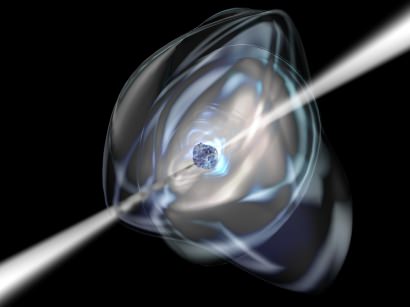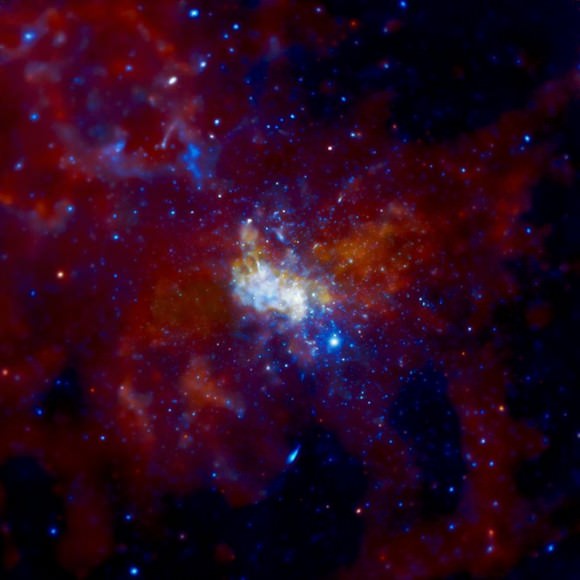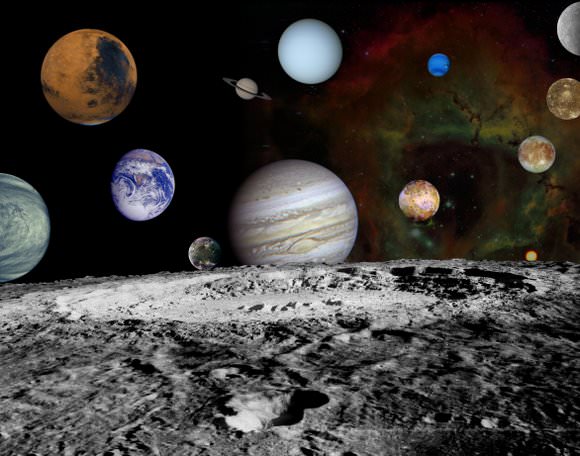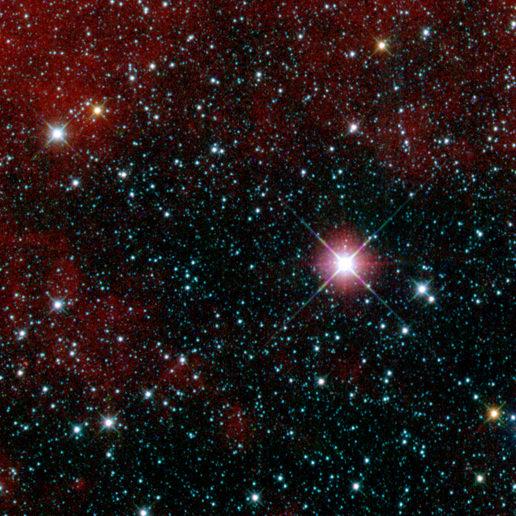Weekend SkyWatcher's Forecast – January 8-10, 2010
Greetings, fellow SkyWatchers! While the skies don't change a whole lot from year to year, how you approach astronomy and what you can do with your "astronomy time" certainly does! We begin the weekend with a variable star and a great galaxy. Ready for more? Then why not tackle an historic learning project with Mars? No scope or binoculars? No problem. There's still lots of cool things you can do when you know where to look! Whenever you're ready, I'll see you in the backyard….(...)
Read the rest of Weekend SkyWatcher's Forecast – January 8-10, 2010 (1,890 words)
NASA Science News for January 8, 2010 10:00:00 AM
Most astronomers wouldn't dream of opening their observatory's doors in 100 mph winds. Yet NASA's new SOFIA telescope recently flew in an airplane at 250 mph with doors wide open. The successful test is an important step forward for infrared astronomy.
FULL STORY at
http://science.nasa.gov/headlines/y2010/08jan_flyingtelescope.htm?list1035898
Supernova Simulations Point to White Dwarf Mergers
Type Ia supernovae, some of the most violent and luminous explosions in the Universe, have become a handy tool for astronomers to measure the size and expansion of the Universe itself. Because they explode with a rather specific peak luminosity, they can be used as "standard candles" to measure distances. New research presented at the American Astronomical Society meeting this week points to the increased likelihood that the mergers of the stars that create these explosions, white dwarfs, is more likely than previously thought, and could explain the properties of some Type Ia supernovae that are curiously less luminous than expected.(...)
Read the rest of Supernova Simulations Point to White Dwarf Mergers (460 words)
Another Antimatter Supernova Discovered
Here's another extremely explosive supernova that can be chalked up to the production of antimatter in the core of the star: Y-155. These types of supernova explosions – which can be ten times brighter than the already spectacular explosion of a Type Ia supernova – have been theorized to exist for over forty years. About a month ago, we reported on the first observations of one of these types of supernovae, and at the American Astronomical Society super-meeting yesterday, Peter Garnavich of the University of Notre Dame presented on the observation of a second.(...)
Read the rest of Another Antimatter Supernova Discovered (513 words)
Faster-Than-Light Pulsar Phenomena

Observational data from nine pulsars, including the Crab pulsar, suggest these rapidly spinning neutron stars emit the electromagnetic equivalent of a sonic boom, and a model created to understand this phenomenon shows that the source of the emissions could be traveling faster than the speed of light. Researchers say as the polarization currents in these emissions are whipped around with a mechanism likened to a synchrotron, the sources could be traveling up to six times light speed, or 1.8 million km per second. However, although the source of the radiation exceeds the speed of light, the emitted radiation travels at normal light speed once it leaves the source. "This is not science fiction, and no laws of physics were broken in this model," said John Singleton of Los Alamos National Laboratory at a press briefing at the American Astronomical Society meeting in Washington, DC. "And Einstein’s theory of Special Relativity is not violated."
(...)
Read the rest of Faster-Than-Light Pulsar Phenomena (541 words)
Spitzer Peers Into the Small Magellanic Cloud
This week at the AAC Conference, astronomers released a new image of the Small Magellanic Cloud (SMC, a dwarf galaxy just outside our Milky Way) from Spitzer. The purpose of the image was to study "the life cycle of dust in this galaxy." In this life cycle, clouds of gas and dust collapse to form new stars. As those stars die, they create new dust in their atmosphere which will enrich the galaxy and, when the stars give off that dust, will be made available future generations of stars. The rate at which this process occurs determines how fast the galaxy will evolve. This research has shown that the SMC is far less evolved than our on galaxy and only has 20% of the heavy elements that our own galaxy has. Such unevolved galaxies are reminiscent of the building blocks of larger galaxies.
(...)
Read the rest of Spitzer Peers Into the Small Magellanic Cloud (194 words)
Measuring the Coronal Temperature with Iron
This image of the solar corona contains a color overlay of the emission from highly ionized iron lines and white light taken of the 2008 eclipse. Red indicates iron line Fe XI 789.2 nm, blue represents iron line Fe XIII 1074.7 nm, and green shows iron line Fe XIV 530.3 nm. This is the first such map of the 2-D distribution of coronal electron temperature and ion charge state. Credit: Habbal, et al.
Astronomers presenting at this week's AAS conference have reported on new research measuring the temperature of the solar corona. The work combines observations of the Sun's outer reaches from observations during total solar eclipses in 2006, 2008, and 2009. It utilized mapping of various abundances of ionized iron to build a two dimensional temperature map.
(...)
Read the rest of Measuring the Coronal Temperature with Iron (387 words)
WISE
Caption: WISE First Light image. Image credit: NASA/JPL-Caltech/UCLA
"In many respects, the most important moment for a telescope is its first light," said Bill Irace, project manager for the Wide-field Infrared Survey Explorer (WISE) spacecraft, speaking at the 215th American Astronomical Society meeting. "And we are happy to be able to share WISE's first light image with you today." The image covers a patch of sky about three times larger than the full moon. An interstellar dust cloud shows in the upper left, and the bright object in the right-center is V 482 Carina, an old puffy, cool giant star. The image was taken with what will be WISE's standard 8.8 seconds of exposure time where it "stares" at a specific point in the sky. Ultimately, WISE will take millions of images to conduct an all sky survey in 10 months, before the frozen hydrogen that keeps the instrument cold evaporates away.
(...)
Read the rest of WISE "First Light" Image Released (288 words)
NASA Science News for January 7, 2010
NASA is building a new space telescope named "NuSTAR" to answer a question that has been vexing astrophysicists for decades: Why won't the supernova explode?
FULL STORY at
http://science.nasa.gov/headlines/y2010/07jan_nustar.htm?list1035898
Arp's Phantom Jet
During the “Great Debate” of 1920 astronomers Herber Curtis and Harlow Shapley had a famous debate on the nature of “spiral nebulae”. Curtis argued they were “island universes” or what we would today call a galaxy. Shapley was of the opinion that they were spiral structures within our own galaxy. One of the evidences Shapley put forth was that another astronomer, Adriaan vanMaanen, had reported detecting rotation of these objects over a period of years leading to an overall rotation rate of ~105 years. If these spiral nebulae were truly as far (and thus, as large) as Curtis suggested this would mean they would be rotating well beyond the speed of light at their outer edges.
It was later determined vanMaanen's rotation was a case of wishful thinking when Hubble eventually determined the true distance to the Andromeda galaxy. From then on, it was well established that galaxies are so large, their motions will not be observed in human lifetimes. Aside from local flare ups of supernovae and other such events, galaxies should be relatively static. Yet in just over 40 years, a distinct, large-scale feature in the galaxy NGC 3303 seems to have disappeared entirely.(...)
Read the rest of Arp's Phantom Jet (457 words)
Early Release Science from Hubble WFC3 at AAS Conference

The image above is a newly released image from the Hubble Space Telescope. The image shows a mosaic of a portion of the Great Observatories Origins Deep Survey (GOODS) South Field nearly 1/3 the size of the full moon taken in September and October of 2009. It combines data taken in 10 filters that span the infrared to near ultraviolet. It made use of the newly installed Wide Field Camera 3 (WCF3) and the Advanced Camera for Surveys (ACS). The survey used 100 Hubble orbits for images from the ACS and 104 for the WCF3 images. Galaxies in the image are as faint as 26.5th to 27th magnitude which is several thousand times fainter than can be viewed with the naked eye and shows 7,500 galaxies.
Some of the first science results from this image were discussed this morning at the AAS conference in Washington.(...)
Read the rest of Early Release Science from Hubble WFC3 at AAS Conference (334 words)
Chandra Stares Deep into the Heart of Sagittarius A*

Caption: Latest Chandra image of Sgr A*. Credits: X-ray: NASA/CXC/MIT/F. Baganoff, R. Shcherbakov et al.
How long can you stare at an object? This Chandra image of the supermassive black hole at the center of the Milky Way Galaxy, known as Sagittarius A* (or Sgr A* for short)Sgr A* and the surrounding region is based on data from a series of observations lasting a total of about one million seconds, or almost two weeks. Such a deep observation has given scientists an unprecedented view of the nearby supernova remnant, known as Sgr A East, and the lobes of hot gas extending for a dozen light years on either side of the black hole. These lobes provide evidence for powerful eruptions occurring several times over the last ten thousand years. But this image also provides evidence that Sgr A* isn't a very good eater.
(...)
Read the rest of Chandra Stares Deep into the Heart of Sagittarius A* (343 words)
New Pulsar
This illustration shows a pulsar's magnetic field (blue) creates narrow beams of radiation (magenta). Image credit: NASA
How do you detect a ripple in space-time itself? Well, you need hundreds of precision clocks distributed throughout the galaxy, and the Fermi gamma ray telescope has given astronomers a new way to find them.
The "clocks" in question are actually millisecond pulsars – city-sized, sun-massed stars of ultradense matter that spin hundreds of times per second. Due to their powerful magnetic fields, pulsars emit most of their radiation in tightly focused beams, much like a lighthouse. Each spin of the pulsar corresponds to a "pulse" of radiation detectable from Earth. The rate at which millisecond pulsars pulse is extremely stable, so they serve as some of the most reliable clocks in the universe.
(...)
Read the rest of New Pulsar "Clocks" Will Aid Gravitational Wave Detection (250 words)
How Common are Solar Systems Like Ours?

Solar system montage. Credit: NASA
On the whole, we'd like to think we're special, but we also hope we aren't alone in the Universe. Astronomers have been trying to figure out just how common solar systems like ours are across the cosmos, and during one moment of epiphany one scientist figured out how to make the calculations. It took a worldwide collaboration of astronomers to do the work, but they concluded that about 10 percent of stars in the universe host systems of planets like our own, with several gas giant planets in the outer part of the solar system.
"Now we know our place in the universe," said Ohio State University astronomer Scott Gaudi. "Solar systems like our own are not rare, but we're not in the majority, either."
(...)
Read the rest of How Common are Solar Systems Like Ours? (529 words)
Kepler Discovers Planets-like Objects Hotter Than Stars
Possible habitable zones around stars. Credit: Kepler mission
The Kepler mission announced the discovery of 5 new extrasolar planets today at the American Astronomical Society meeting in Washington, DC, each with some very unusual properties. But additionally, the space telescope has spotted some Jupiter-sized objects orbiting stars, and these objects are hotter than the host star. The science team has no idea what these objects could be, but they are part of 100 planetary candidates Kepler has observed that are still being analyzed.
(...)
Read the rest of Kepler Discovers Planets-like Objects Hotter Than Stars (337 words)








